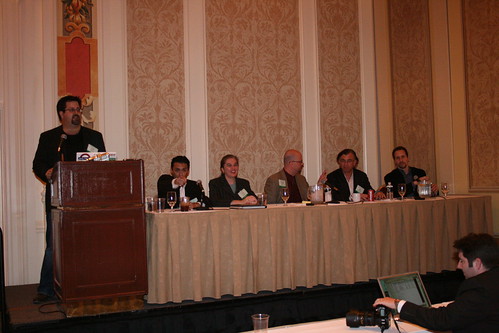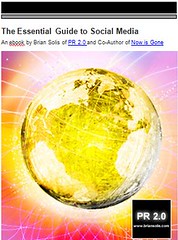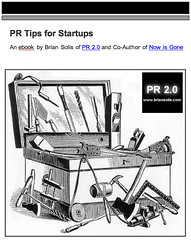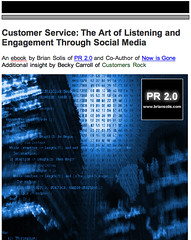Social Media Release in the Spotlight Again

Click "download" to read it in Word.
Download
View
Here we go again, but this time the discussion is finally happening among those who can benefit from the discussion the most – the PR industry. We took the conversation offlline to convince PR to be more effective with press releases first, before they can worry about the “why, how, when, and where” related to social media releases.
I recently spoke at the New Communications Forum on the now controversial topic of the Social Media Release aka hrelease aka New Media Release as part of the panel that comprised of those most vocal about it - Todd Defren (the man behind the SMPR template), Tom Foremski (the journalist that started it all), and Chris Heuer (the social media evangelist who is bringing everyone together). Laura Sturaitis from BusinessWire and George Vazquez of PRNewswire also joined the discussion.
The goal of this panel was to deliver clarity and understanding to the critics and those generally confused about what the hell we’re talking about and what we’re trying to accomplish. This was, after all, one of the largest conferences dedicated to helping PR people understand new media, Social Media, and other online tools, and how to use - and not use - them in practice. And yes, this could be an entirely separate discussion.
Back to the panel.
I will start by saying that we didn’t really do the best job because we left attendees with more questions than answers. We were also sidetracked into an irrelevant discussion of wire pricing and disclosure, which monopolized the discussion. (Wire services should take note: there is a genuine hate/hate relationship with you. Drop your prices!)
Let’s start with the questions that were raised onsite and in the blogosphere:
What’s wrong with press releases as is?
How do we make it more affordable to cross on the wire?
How do social media releases comply with Reg FD? (It shouldn’t, move on.)
Where are the case studies?
Why don’t we get more input from journalists on what they want?
Why does it need to be socialized?
Look, I’m of the belief that most of the PR people shouldn’t even think about dabbling in the world of Social Media until they do much more than simply learn about it. In my opinion, they first need to determine what they stand for before they can even think about social media releases. But, there are some that are genuinely capable of participating.
Let’s start with what a Social Media Release is not…
It’s not a magic pill to cure the ills of the traditional press releases
It’s not about RegFD and disclosure
It’s not exclusively for journalists
It’s not designed to replace a press release
It was not created as a cash cow so that PR can create new value for itself
It’s not the same as a new media or multimedia release as advertised by wire services
And, here are the kickers…
It’s not at all about using a template, it was never meant to be…the original was designed to help explain how/where to start
It should NEVER cross a wire
And, it’s not about BULLSHIT or SPIN
Oh yeah…I just said that.
You know what it is? It’s a bigger discussion about sharing official news in way that reaches people (which should include bloggers and journalists too) with the information that matters to them, in the ways that they use to digest and in turn share with others through text, links, images, video, bookmarks, tags, etc., while also giving them the ability interact with you directly or indirectly. It also helps new people find the information in different ways. All this, without the BS.
We don’t need focus groups to ask journalists what they want. We already know that most reporters despise the press release - that should come as no shock to people, yet it always seems to.
My argument is that there should be multiple flavors of a (well written and targeted) press release, traditional, new media, and social. No one tool reaches everyone, nor should it. Why limit the opportunity for distributing important information and why be so foolish to believe that one message matters to all who read it?
Too many people assume that releases (whether social or traditional) are only intended for the press (or bloggers). Stats already show that consumers are reading press releases that they find through search engines as well.
This changes the landscape and definitely reinforces the notion that one press release no longer serves all. You can still send a release to journalists, and at the end of the day, if you customize your story for different markets and the people within them, then you can only increase WOMM.
If you look back to Foremski's original post, he says nothing about adding social elements, only media resources (links) and relevant information in a concise format (without being "spintastic.")
Wire services are expensive, and if you look at the very root of an SMR, I suggest that it has no place on a wire - it goes against the very premise of social media.
Wires already offer SEO advantages to traditional press releases that enable them to also reach users through search marketing in addition to journalists. I believe that SMRs can also reach people directly, but through different channels.
But, if you write a good release/s (almost as if it was the story you'd want to read in the press) with new media elements, such as integrated resource links, video, images, etc. (and lite social elements such as del.icio.us and Digg), the release would enjoy more success with journalists and readers in general and will most likely cost no more than what you do today. Plus, it will have SEO benefits.
Now, if you created a dedicated blog-like platform, for example, and distribute your information in a genuine and hype-free way, that distribution channel, by default, is already socially-enabled. It is a recognized mechanism for socializing information simply by the way it is constructed with integrated comments, RSS feeds, social bookmarking, trackbacks, tags, etc. It shouldn't look like a press release, but it should provide what's new in a conversational, informative and resourceful format.
This does require an entirely new approach, but unlike traditional releases, if written the right way, it can engage readers in a way never before possible. But first, you have to know what you’re talking about and why it matters to those you’re trying to reach.
Maybe I have a different vision for a social media release, but I don't see it ever targeting journalists per se, and I absolutely don't believe it belongs on the wire. But, I guarantee you this, just by thinking about what you want to say, what you should say, distilling it in a way that matters to the people who read it, and provide links, resources, and other forms of telling the story, you will have greater traction with reporters, bloggers, and customers, whether social or not.
And let's not forget that nothing replaces relationships.
Here's a bit more on the subject:
Don’t Kill the Press Release, Shoot the Messenger
Forrester's Josh Bernoff recommends using your brain
When Will We Afford a Social Media Release - Kari Hanson
Social Media News Release: The Right Tool for the Job? – Kami Huyse
The social media release: the jury’s still out - Joseph Thornley (Who’s the jury?)
Social media release panel at the NewComm Forum - Mike Keliher
NewCommForum: The Social Media Press Release – Chip Griffin
pr pr2.0 publicrelations public+relations public relations social media socialmedia social+media smr hrelease socialmediarelease pressrelease press+release brian+solis tom+foremski todd+defren socialmedaclub businesswire prnewswire chris+heuer media2.0 media+2.0 2.0












8 Comments:
Brian; I am glad you summarized your thoughts here, because you are right that the session at New Comm didn't do it. In many ways I would have to agree with you, though I think that others are indeed trying to get a format (hRelease) that would be recognized on the wire. However, I think that we have too many issues that are all mixed up in this debate. They are: content, form and distribution, and each point has a bevy of opinions around it. Then there are a number of people who might read or use one of these releases: journalists, bloggers and social media types, and people searching for the information. This is quite a number of variables to sort out, as you point out in your post.
Brian, thanks for the link and for your additional ideas on this jazz. You're right, the session wasn't all it could have been, and the audience did leave with a lot of unanswered questions. Hopefully, though, that will pique their interest more than discourage them.
That said, a one-hour panel for this is not enough. That room was packed, and I would gladly have spent the whole conference talking about this one issue.
What do you say we fire up an SMR Summit later this year? You're in Cali right? I'm in Minneapolis, so we'll meet in the middle. How 'bout the Venetian in Vegas? :)
Good recap, Brian, though I don't agree that a SMPR should never go over the wires. I believe that for the forseeable future, the wires serve a purpose: distribution as wide as possible, including to hard-to-reach outlets (Yahoo News, etc.) and more isolated sources (local metro papers).
p.s. - GREAT to see you last week. Let's catch up again soon.
Thanks, Brian. Posts like this are especially useful to those of us who weren't lucky enough to make it to Vegas.
I'd also have to argue for the importance of social media news releases and the wire. We may call it something else, but we still need some way to collect and distribute social media releases.
We can't rely on 'search' for our news; it's not practical to look for our news on every company's website; and I don't want to wade through all of the junk at services like Digg.
So how do we discover legitimate news using our brave new media releases?
That's one of the things that I'm working on at FetchWire.com. Like the release itself, the "wire" concept isn't really broken. It just may need to be retooled for our social media world.
Kami, you're right. I hope we can keep this discussion going because there's much to explain. The hRelease format is indeed the most important product of this process....that and also helping people understand Social Media as well as writing more effectively.
Mike, done deal. Let's get Todd, Chris, and Tom to get it going in Vegas!
Todd, Shannon, I don't disagree with you. I did suggest that a "lite" social version of a release (perhaps a hybrid between a variety of formats) cross the wire for search and reporters.
Ultimately, with the hRelease format, we can broadcast it officially through a number of ways.
In my opinion though, if we're talking pure Social Media, we should also evaluate other avenues.
When we're talking about telling a story with integrated new media and social media elements using the reach of the wires, let's continue to experiment.
My only argument about aligning socially-tuned releases for the wire is that they only provide for somewhat socialized distribution...which is why I call them "lite" - bookmarks, digg, RSS links, etc.
As we all know, there's much more behind social media. The tools and the ability to interact with and share information are far more extensive than the wires currently (and maybe should never) provide.
For all PR people looking to learn, please remember, that news is also about relationships and how we get the story to them in a way that matters to their community.
There was way too much to cover in one hour, and the fact is that we don't have all the answers yet anyway. Distribution and communications go hand in hand so it is a vital component of the discussion. And Kami is right, there are many variables. And there will be many types of media released by companies--we might call some of them "social." What is clear is that companies need to think in terms of a "mediacast" and publish in many new media formats, and distribute and collect responses over many different communications chanells.
It's an incr4easingly fragmented media world and like it or not, that means the PR industry has to adapt to it. And I think that's the work that I and my fellow panel members are doing--helping others in the industry to understand the new rules in communications and how best to adapt to them.
Reading your post Brian, and a lot of the other stuff over the last month or so, I wonder if it would be helpful to include a little more clarity around the terms (as they are currently used) hRelease and SMR?
It seems to me that a lot of the discussion presupposes that these terms are equivalent, or at least closely related, when at the moment that is not necessarily the case - although the community may work to close that gap.
Ideally, I would like to think that hRelease would make news more discoverable (and digestible/reusable) to the public (particularly those using assistive technologies), to journalists and pr professionals and to machines - and fwiw my preference would be in that order.
Interested to see how this could be resolved.
Post a Comment
<< Home